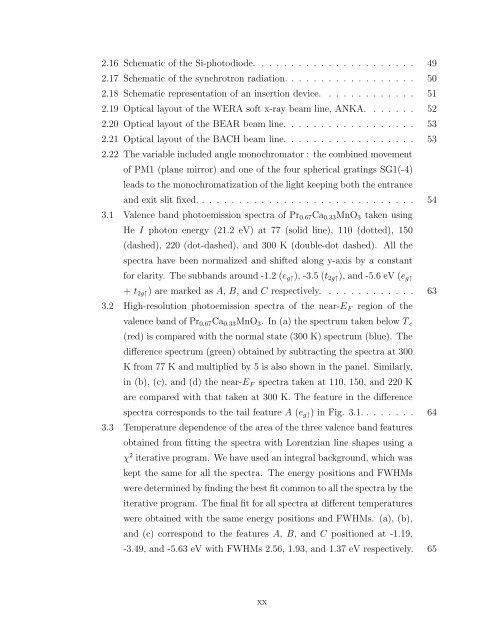PHYS07200604007 Manas Kumar Dala - Homi Bhabha National ...
PHYS07200604007 Manas Kumar Dala - Homi Bhabha National ...
PHYS07200604007 Manas Kumar Dala - Homi Bhabha National ...
Create successful ePaper yourself
Turn your PDF publications into a flip-book with our unique Google optimized e-Paper software.
2.16 Schematic of the Si-photodiode. . . . . . . . . . . . . . . . . . . . . . 49<br />
2.17 Schematic of the synchrotron radiation. . . . . . . . . . . . . . . . . . 50<br />
2.18 Schematic representation of an insertion device. . . . . . . . . . . . . 51<br />
2.19 Optical layout of the WERA soft x-ray beam line, ANKA. . . . . . . 52<br />
2.20 Optical layout of the BEAR beam line. . . . . . . . . . . . . . . . . . 53<br />
2.21 Optical layout of the BACH beam line. . . . . . . . . . . . . . . . . . 53<br />
2.22 The variable included angle monochromator : the combined movement<br />
of PM1 (plane mirror) and one of the four spherical gratings SG1(-4)<br />
leads to the monochromatization of the light keeping both the entrance<br />
and exit slit fixed. . . . . . . . . . . . . . . . . . . . . . . . . . . . . . 54<br />
3.1 Valence band photoemission spectra of Pr 0.67 Ca 0.33 MnO 3 taken using<br />
He I photon energy (21.2 eV) at 77 (solid line), 110 (dotted), 150<br />
(dashed), 220 (dot-dashed), and 300 K (double-dot dashed). All the<br />
spectra have been normalized and shifted along y-axis by a constant<br />
for clarity. The subbands around -1.2 (e g↑ ), -3.5 (t 2g↑ ), and -5.6 eV (e g↑<br />
+ t 2g↑ ) are marked as A, B, and C respectively. . . . . . . . . . . . . 63<br />
3.2 High-resolution photoemission spectra of the near-E F region of the<br />
valence band of Pr 0.67 Ca 0.33 MnO 3 . In (a) the spectrum taken below T c<br />
(red) is compared with the normal state (300 K) spectrum (blue). The<br />
difference spectrum (green) obtained by subtracting the spectra at 300<br />
K from 77 K and multiplied by 5 is also shown in the panel. Similarly,<br />
in (b), (c), and (d) the near-E F spectra taken at 110, 150, and 220 K<br />
are compared with that taken at 300 K. The feature in the difference<br />
spectra corresponds to the tail feature A (e g↑ ) in Fig. 3.1. . . . . . . . 64<br />
3.3 Temperature dependence of the area of the three valence band features<br />
obtained from fitting the spectra with Lorentzian line shapes using a<br />
χ 2 iterative program. We have used an integral background, which was<br />
kept the same for all the spectra. The energy positions and FWHMs<br />
were determined by finding the best fit common to all the spectra by the<br />
iterative program. The final fit for all spectra at different temperatures<br />
were obtained with the same energy positions and FWHMs. (a), (b),<br />
and (c) correspond to the features A, B, and C positioned at -1.19,<br />
-3.49, and -5.63 eV with FWHMs 2.56, 1.93, and 1.37 eV respectively. 65<br />
xx
















